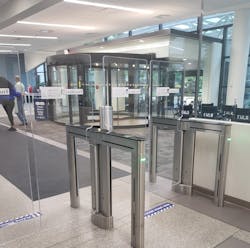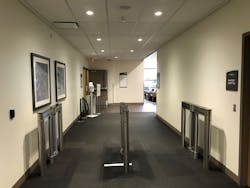Vanguard Award Boxerbaum Award Winner: Froedtert Hospital Security Retrofit
This article also appears in the November 2021 issue of Security Business magazine.
In any large security technology systems retrofit project, the final result is usually only as good as the collaboration of its collective partners.
With more than 35,000 discharges, 800,000 ambulatory and 75,000 emergency room visits a year, control over the environment is paramount to providing care while ensuring a safe environment for patients and staff.
With the initial project foundation laid by Business Protection Specialists, Inc. (BPS) – the consultant chosen in a national selection process to conduct a risk assessment, initiate the programming phase for the project and help make the business case for visitor management and access control – the project’s deployment team was formed with BPS joining Minnesota-based integrator VTI and Milwaukee-based architectural firm Kahler Slater.
According to Frank Pisciotta, CSC, who, as President and CEO of BPS, spearheaded the project that began with initial assessments in June 2018, the vision of the Froedtert “Access Management Project” was to require all staff, patients, visitors and all others to check in upon entering the hospital.
But he adds that there were many challenges the team had to overcome, such as administrator buy-in, software constraints, space constraints, workflow, code compliance, cultural changes, financial, IT support and patient experience changes.
Pisciotta and his team team championed the idea of implementing optical turnstiles, a technology that many hospital administrators avoid.
“Many hospital administrators are highly focused on an open environment and resist the recommendations of their internal security leaders to use restrictive measures such as enhanced access control,” Pisciotta explains. “Often it is the use of an outside independent consultant that can be the tipping point to push a concept across the finish line. Through collaboration and effective project management, the initiative ultimately exceeded its intended results and sets a much-needed precedent in the healthcare industry.”
Based on the difficulty of this fast-paced project that required not only an overhaul in workplace culture but a reimaged technology approach, the project has been named the 2021 Boxerbaum Security Project of the Year. Named for the late Elliot A. Boxerbaum, the project award is presented annually at the CONSULT Technical Security Symposium to a consulting firm as part of the Security Vanguard Awards. Pisciotta accepted the award for the Froedtert Hospital project at the Oct. 25 event in San Antonio.
The Hospital Access Control Conundrum
Pisciotta points out that hospitals have historically been restrictive environments until research and evidence proved that family interaction had a positive impact on many patient care outcomes. As a result of this evidence, hospitals have become less restrictive with their access control methods over the last two decades.
Many U.S. hospitals further eliminated access control measures and eased visitation restrictions in 2010 due to changes in the law that protected patient visitation rights. While relaxing visiting hours is beneficial to the health and recovery of patients, this trend placed a greater burden on security departments and medical staff, who needed to ensure that everyone in the facility can be easily identified and have the proper controls and privileges placed on their access. This called for better access control and visitor management at the perimeter.
“There is a clear case to take the burden off nursing and move it back to security as was done here [at Froedtert],” Pisciotta explains. “Hospital administrators need to prioritize patient, visitor and staff safety equally.”
These meetings included an overall discussion of the visitor management application, the possibility of optical turnstiles, and limiting entry points into the facilities in order to monitor who was on campus.
The BPS access control master planning report illustrated how increased security would be a positive change for all departments – with the goal of decreased incidents, stronger targeted presence for main entry points, ability to track visitors, and create a reporting tool for staffing. To make similar assessments of the visitor management system in a live hospital deployment, Pisciotta and Froedtert Security Director Michael Ramstack visited a Children’s Hospital in Columbus, Ohio, which had already successfully implemented a similar system.
Changing the Security Mindset
The challenges of migrating security technology not usually associated with a hospital environment required innovative approaches. Technology and product development have advanced more quickly than adopted building and life safety codes, which is especially the case with turnstiles.
The 2015 and earlier editions of the International Building Code (IBC)
refer to traditional turnstiles with three rotating arms, and their use is limited to specific dimensional and operational requirements. If located within an egress path, they are limited to 50% of the occupant load passing through them.
These “old-school” turnstiles would not allow wheelchairs or stretchers to pass through, and they would not provide the level of security required and at any given hospital’s main entrance, where more than 50% of occupants would need to pass through them.
“One of the challenges was to engage with the AHJs (authorities having jurisdiction) for approval of a variance that would allow the use of a newer turnstile technology with a bi-parting automatic gate/door,” Pisciotta explains. “Fortunately, newer but not-yet adopted codes have acknowledged this need and include a section on security access turnstiles.”
The security consulting and deployment team demonstrated to the AHJ how patients in wheelchairs and beds would be accommodated by the turnstiles for exiting during both normal and emergency conditions, such as fire or loss of power.
“It led everyone to quickly gain alignment, and when the formal variance request was submitted, it was approved,” Pisciotta says.
The Deployment
Dan Krueger, VTI’s Wisconsin Branch Manager, helped BPS coordinate the integration of Alvarado optical turnstiles with HID Global’s SAFE visitor management solution and the Genetec security management systems.
“Setting expectations that are realistic, and getting all parties involved are critical elements in getting any project to stay on target and keep the clients engaged,” Krueger says. “When we do integrations like this, especially in a hospital, it affects everybody. The security technology plan had to be welcoming, and that was key to any design, systems or devices that were brought in.”
“A lot of it – especially the actual bolting devices onto a floor – involved a lot of pre-planning, meetings and client demonstrations,” Krueger says. At one point, we brought a set of the turnstiles and put them in a conference room, and we left them there for a few days and invited all staff to walk through them and see how they felt and see if they felt comfortable.”
Krueger adds that in addition to the demo turnstile unit in the conference room, each potential entryway location was walked and identified with the collaboration of BPS, VTI, the security and facilities on-site teams, along with the electrical and low voltage techs and IT departments.
Each location where turnstiles would be deployed needed to take into consideration the flow of staff and visitors. Turnstiles also needed to allow for enough space and flow for peak times, gurneys, deliveries and day-to-day traffic. The turnstiles were required to be stationed next to security officer staffing stations and possess the ability to screen visitors, respond to breaches of the units and also maintain a hospitable experience for all.
The readers used in the turnstiles were also a part of the future expansion plans of the hospital, as they could accommodate multiple technology options for visitor/staff badging and identification – including proximity cards, barcodes and QR codes.
Planned future integrations include adding facial recognition analytics applied with the Genetec VMS, and video camera integration for reporting alarms, breaches and weapons detection at turnstile entry points.
“Benchmark meetings were held to align progress and project management with many of the stakeholders involved as the progression of the systems went forward,” Krueger says. “Training for the new systems and applications began at a very early stage, with additional training being done on-site, utilizing a ‘train the trainer’ focus.”
Project Objectives Deemed a Success
For Pisciotta and the rest of the project team, success was achieved – most importantly in that hospital administrators realized they could strengthen security and safety while also increasing patient and staff satisfaction.
“Ultimately, by incorporating this concept, Froedtert Hospital is positioned to have world-class access control management, enabling all doors to be controlled at all times, all non- Froedtert Hospital personnel to be properly identified and screened, and creating the most secure environment for staff and patients,” Pisciotta says.
The system also brought with it tangible benefits, including:
- Nurses gained significant time to care for patients rather than managing visitors, which is now performed at the perimeter of the facility.
- Hospital security can now control large numbers of people prior to gathering inside the hospital, where it becomes more difficult to manage.
- Nearly 70% of hospital staff surveyed reported that the access control project increased their feeling of safety.
- Nearly 60% of hospital staff surveyed reported that the access management pilot decreased stress levels when caring for patients.
Steve Lasky is Editorial Director of Endeavor Business Media Security Group. Read about the other Vanguard Award projects at www.securityinfowatch.com/vanguard.
Project Overview: Froedtert Hospital Project
- Project submitted by: Frank Pisciotta, president/CEO, Business Protection Specialists, Inc., Raleigh, NC
- End-User: Froedtert Hospital, Milwaukee, Wis.
- Additional collaboration: Integrator: VTI (https://www.vtisecurity.com/), Architect: Kahler Slater (https://www.kahlerslater.com/)
Manufacturers and products used:
- Turnstiles: Alvarado
- Visitor Management Platform: HID SAFE
- Security Management System: Genetec Security Center
 The Boxerbaum Security Project of the Year is presented to a security consulting firm annually at the CONSULT Technical Security Symposium and honored by Security Technology Executive (STE) and Security Business magazines as part of the Vanguard Awards. The Boxerbaum award is named for the late Elliot A. Boxerbaum, MA, CPP, CSC, founder and president of Security Risk Management Consultants Inc., who passed away in June 2014 from ALS.
The Boxerbaum Security Project of the Year is presented to a security consulting firm annually at the CONSULT Technical Security Symposium and honored by Security Technology Executive (STE) and Security Business magazines as part of the Vanguard Awards. The Boxerbaum award is named for the late Elliot A. Boxerbaum, MA, CPP, CSC, founder and president of Security Risk Management Consultants Inc., who passed away in June 2014 from ALS.
About the Author
Steve Lasky
Editorial Director, Editor-in-Chief/Security Technology Executive
Steve Lasky is Editorial Director of the Endeavor Business Media Security Group, which includes SecurityInfoWatch.com, as well as Security Business, Security Technology Executive, and Locksmith Ledger magazines. He is also the host of the SecurityDNA podcast series. Reach him at [email protected].




